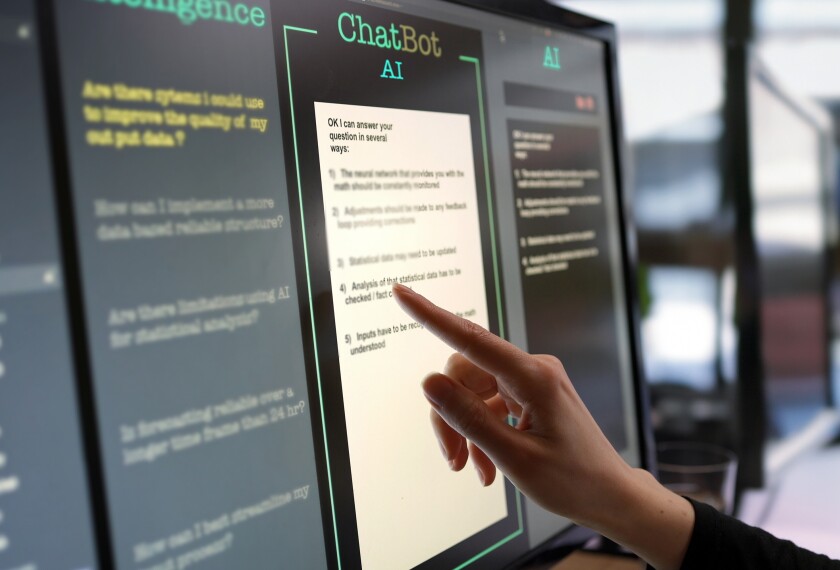The role of artificial intelligence in classrooms is rapidly evolving, and Ő«–ń∂Į¬Ģvlog are divided over how to handle it.
Teachers are using AI to draft lesson plans, brainstorm solutions, and identify where students are struggling. But students’ use of AI is raising new ethical and instructional questions.
Many teachers cite generative AI platforms as a common tool for students to cheat on assignments, while some critics warn about potential cognitive effects for students who rely on AI instead of developing their own skills.
Some states and school districts have adopted AI policies, but others have not‚ÄĒcreating a patchwork approach that leaves room for misuse. Educators‚Äô comfort with AI varies widely. However, as Tanisca Wilson, a member of the National Council of Teachers of English, said, ‚ÄúAI is our friend and not our enemy.‚ÄĚ
‚ÄúWe need to reimagine what we can do with such a powerful tool,‚ÄĚ she said.
To do that, Wilson said Ő«–ń∂Į¬Ģvlog must shift their mindset from seeing AI as a tool that suppresses critical thinking to viewing students as contributors who can shape how AI is used.
She added that for students to develop their creative voice, it‚Äôs important for Ő«–ń∂Į¬Ģvlog to demonstrate both the benefits of generative AI‚ÄĒsuch as revising a paragraph‚ÄĒand its limitations.
‚ÄúYou can‚Äôt be equally proud of something that a computer has generated,‚ÄĚ Wilson said.
As more generative AI technologies become available, some teachers employ AI-detection tools, whose effectiveness at accurately detecting plagiarism has been questioned. Wilson said some Ő«–ń∂Į¬Ģvlog are shifting to a more in-class model of assessments instead of traditionally assigning homework because of the rise in generative AI.
In a May and June 2023 EdWeek Research Center survey about how math instruction should‚ÄĒif at all‚ÄĒchange to address the existence of AI platforms that can solve math problems for students, 43% of teachers, principals, and district leaders said students should solve problems in class using pencil and paper. Thirty-seven percent said students should explain their solutions orally, while 34% said students should be taught to incorporate AI into math assignments.
Classroom strategies in action
Ana Sepulveda, a 6th grade math and dual-language teacher in the Dallas Independent school district, said she allows her students to use generative AI platforms for specific assignments, such as translanguaging their curriculum. She added that although she assigns online learning modules, students are required to show their work in a journal, which counts as a project grade.
‚ÄúThat journal [is] the story of how much work they‚Äôre putting in, day in and day out,‚ÄĚ Sepulveda said.
Lisa Apau, a high school science teacher in Massachusetts’ Worcester public schools, said she encourages her students to use AI platforms, but for situations when they don’t understand course material.
‚ÄúI‚Äôm not going to fight that battle. What I want to do is ... encourage kids to use it with ethics,‚ÄĚ she said.
To discourage students from inappropriately leaning on generative AI, Apau recommends that Ő«–ń∂Į¬Ģvlog design assignments creatively. In her anatomy classes, for example, Apau asks students to draw parts of the body. Although not a direct result of more AI platforms, Apau said those methods make it harder for students to cheat.
Keeping students engaged while defining responsible use
At High Tech Los Angeles, a charter school in California, teachers use a project-based learning model to limit reliance on AI and assess students’ learning skills.
‚ÄúIf they get involved in a project, and are super passionate about it, and there‚Äôs a lot of buy-in, they don‚Äôt need to or want to use AI,‚ÄĚ said Bianca Batti, an English teacher at High Tech High. ‚ÄúA lot of it is incumbent on me, as the educator, to make sure I am engaging in the kind of praxis and curriculum development and pedagogy that speaks to students.‚ÄĚ
Ellese Jaddou, a chemistry teacher at the school, has seen students use generative AI platforms as a ‚Äúsupplement to Google‚ÄĚ‚ÄĒsometimes copying homework answers directly from ChatGPT. But she said a smaller portion of her students use it for project inspiration.
In Yakima, Wash., Beth Dallman, a chemistry teacher and International Baccalaureate coordinator at Davis High School, said AI is included in her school’s academic honesty policy, which allows for its use if it is cited as a source.
Before the debate on AI, Ő«–ń∂Į¬Ģvlog wrestled with similar concerns about calculators on students‚Äô math performance. Like calculators, Dallman believes generative AI should be reserved for students age 13 and older‚ÄĒthe minimum requirement for some platforms such as Google Gemini and ChatGPT. Dallman believes Ő«–ń∂Į¬Ģvlog should educate students on how to use AI as a resource‚ÄĒlike a search engine or calculator‚ÄĒas she said it is ‚Äúgoing to be part of everyone‚Äôs life.‚ÄĚ
Regardless of one‚Äôs personal stance, Colleen Molina, the principal at High Tech High, said Ő«–ń∂Į¬Ģvlog must teach students how to use AI responsibly.
‚ÄúI always tell myself, no matter what, we need to educate our students on it. We as a staff need to educate them on the risks of using AI, the [benefits] of using AI, the moral background of using AI, and what you‚Äôre putting out there,‚ÄĚ she said.





